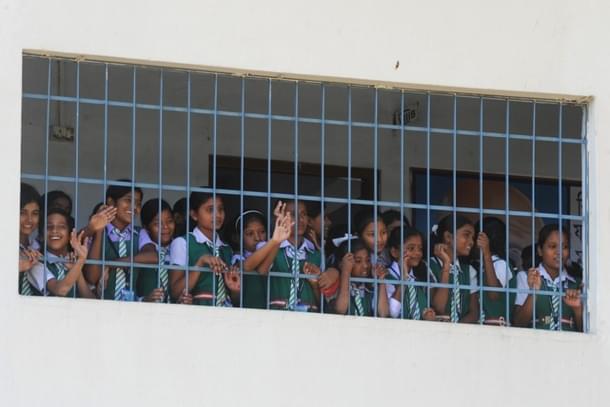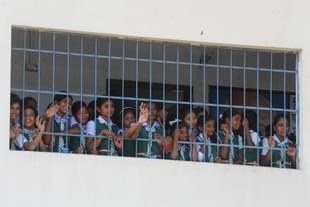Books
Five Suggestions For The New Education Policy
Shivakumar Jolad
Aug 19, 2015, 03:32 PM | Updated Feb 11, 2016, 09:38 AM IST
Save & read from anywhere!
Bookmark stories for easy access on any device or the Swarajya app.


Fix RTE related issues, universalize secondary education and replicate successful government school systems.
The Human Resource Development (HRD) ministry has plans for a massive revamp of the educational scenario through its New Education Policy (NEP). A nationwide consultation process is underway, seeking inputs from all government educational agencies up to the gram panchayat level.
Here are five suggestions:
1. Reformulate the RTE based on outcomes
There is a dire need to revisit The Right of Children to Free and Compulsory Education Act (RTE)-2009. RTE has been successful in providing universal access to elementary education, increasing retention and improving school infrastructure. But it has failed to improve learning levels of children.
The annual nationwide ASER (Annual Status of Education Report) shows that between 2009 and 2014, the reading levels across India (barring a few Southern states) have either declined or stagnated.
Basic arithmetic abilities of children have largely worsened all across the country. The government acknowledges this and has prioritized ensuring the learning outcomes in elementary education as the top priority in the consultation theme.
It needs some introspection as to why, despite increased budgetary outlays, infrastructure and pupil teacher-norms through RTE, the learning levels are showing no signs of improvement.
Perhaps the RTE Act is to be blamed. The Section 16 of RTE states that no child shall be expelled or held back in a class until he/she completes elementary schooling.
Although this was done to remove the burden of exams and prevent dropouts, many teachers feel that this clause has dis-incentivized learning. They complain that rural kids don’t even bother to attend exams citing reasons such as festivals or household events. Children, like adults, respond to incentives, in the absence of which motivation to study and excel subsides.

RTE should do away with the gift of automatic promotion of students, and instead, may provide additional coaching and options of re-appearing in the exams in the same year for badly performing students. Along with this, there is a need for examination reforms.
The NEP consultation theme does stress the need for reforming the examination systems. It is evaluating the feasibility of adopting Continuous Comprehensive Examination (CCE), currently followed by the CBSE board, across all schools.
2. Improve public schools for quality and social integration
Another mandate of RTE which needs careful rethinking is the one-size-fits all approach of reserving 25% of seats (Section 12 (1) (c)) in private schools for the weaker sections of the society. This clause was conceived to expand the options for poor parents to send their kids to private schools, an alibi for the voucher system. It reflects an implicit assumption by the government that private schools are better than the public schools.
There is mixed evidence of whether private schools (barring a few elite schools in urban areas) fare better than public schools. The trend captured by ASER over ten years reveals that, although enrollment in private schools is increasing tremendously even among the poor in rural areas, learning levels have not showed any significant improvement. By mandating reservations in public schools, the Government is abdicating itself of its responsibility towards improving the quality of public schools.
Contrary to its original intent of integrating students of different economic backgrounds, reservation of seats in private schools has created segregation in schools. Many private schools show differential treatment towards these reserved students, and puts them in different sections, citing lack of preparedness as a reason for not being to compete with their regular students.
Way back in 1966, the Kothari Commission had recommended Common School System (CSS) where kids from all socio-economic backgrounds study together and learn from each other’s life experiences. It is essential to bring back the trust in public education system by improving its quality rather than turning blindly to private schools. The Government can learn from its success in schooling systems such as Kendriya Vidyalayas and Navodaya Vidyalayas, which have a proven track record of getting excellent results.
3. Increase budgetary allocation on education
To improve the schooling system, budgetary allocations have to be increased. Right from the time of Kothari Commission, there has been repeated calls by educationalists, NGOs and policy analysts that the governments should allocate 6% of GDP towards education.
However, Indian allocation for education has stuck between 3.5-4% of GDP. In recent times, there is an alarming trend of decreasing central funding to elementary education. An analysis by Accountability Initiative, Center for Policy Research and ASER reveals that central funding for SSA and mid day meal program has decreased from Rs 38,797 crore in 2013-14 to Rs 31, 236 crore in 2015-16.
4. Universalize Secondary Education
India is close to achieving universal access to elementary education. However, elementary education is too basic to provide any life skills or vocational skills for productive employment. The next logical step for government should be to universalize secondary education.
The Rashtriya Madhyamik Shiksha Abhiyan (RMSA) was started in 2009 with the main objective to make secondary education of good quality available, accessible and affordable to all by 2020. One major initiative of RMSA was to set up 6000 Model Schools (one in every block) through state and public-private partnerships, as a benchmark of excellence for providing quality education.
Unfortunately, because of the steep budget cuts, this fiscal year, secondary education has received diminished attention. In a major setback this year, the centre has totally delinked itself from the Model schools program, thereby widening the gap between promise and reality.
5. Replicate successful Government school systems
To provide quality secondary education, the Government can look back at the successful system of Jawahar Navodaya Vidyalayas. Rajiv Gandhi had mooted the idea of setting up NVs in 1986, as part of the National Policy on Education (NPE) to nurture bright rural children. Navodaya Vidyalayas are fully residential rural schools with classes from VI- XIIth. There are about 590 NVs with two lakh students enrolled across all districts in India, barring Tamil Nadu.
The performance of NV students in Xth and XIIth beats the all India average of other CBSE X schools, including Kendriya Vidyalayas. NV students regularly excel in many competitive exams like IITs, UPSC and IIMs among others, and also in sports and many co-curricular activities.
The success of JNVs can be attributed to multiple factors like well-trained teachers who come from all across India, excellent academic and co-curricular infrastructure, and the residential nature of school. Studying under one roof integrates students from all socioeconomic backgrounds and corrects for the household factors that could have prevented students from active participation in academic and co-curricular activities.
The success of the JNVs has to be replicated on a larger scale even if it means substantial investment on every child. According to a recent report, the Government spent Rs 1905 crores on this in 2014-15, which translates to about Rs 85,000 per child. Expansion to all 6000 Talukas in India may cost around Rs. 20,000 crore, a small sum to raise the human capital of 20 lakh potential students when compared to typical physical infrastructure investments by government.
Although India boasts of several research institutions of excellence, research in education is minimal. Most universities do not have any school of education, and none of the IITs and other IIXs have any department of education. NEP gives a golden opportunity to create comprehensive reforms in education and shape our future generation. It must not be wasted.
Shivakumar is an Assistant Professor at IIT Gandhinagar





